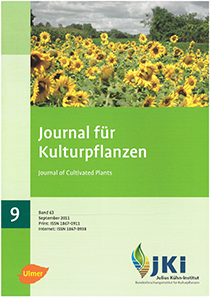Effect of inorganic boron compounds on microorganisms: Evaluation of literature data in view of their suitability as reference compounds in microbiological-ecotoxicological soil investigations
DOI:
https://doi.org/10.5073/JfK.2011.09.01Keywords:
Borate, boric acid, soil, bacteria, fungi, antagonists, mycorrhiza, nitrogen fixation, nitrogen mineralization, nitrification, soil enzymes, ecotoxicological testsAbstract
The significance of microbiological-ecotoxicological tests of pesticides and other pollutants in soils may be improved by including of a suitable reference substance. At present boric acid is already recommended in some zoological tests, but not in microbiological ones. Because no purposeful investigations in this field are available at the time, the following review on the effects of inorganic boron compounds on soil microorganisms should help to decide on the usefulness of boric acid. Boron is known as an essential nutrient for plants, but obviously not for microorganisms and animals. In soils average concentrations of 5–100 mg B/kg are naturally occurring. By anthropogenic additions the soil concentrations of boron can even be increased, whereas leaching or plant uptake may reduce these amounts. In soil the soluble boron mostly occurs as boric acid. Above pH 6.3 the bioavailability of boric acid is decreased by adsorption on soil particles. Inorganic boron compounds are worldwide used in industry, households and agriculture and, therefore, many toxicological investigations exist.
The present review shows a very heterogenic distribution of the available publications on the effects of boron on microbial parameters in soil. Relatively often several microbial populations have been investigated, but many of these publications are many years old. Newer results of boron effects on microbial biomass, diversity and several activities (e.g. soil respiration, N mineralization, nitrification) are seldom. Effects on symbiotic nitrogen fixation, however, have often been investigated, but in most cases the crop plant was the target. As the reviewed publications show, even those concentrations of boron or boric acid naturally occurring in soil or recommended for collembola tests may influence microbial populations or their activities. Depending on dosage and the microbial parameters stimulations and – especially with increasing boron amounts – inhibitions may occur. But often a sound interpretation may be difficult because dose-effect-relations are lacking. Nevertheless the usage of boric acid as a reference compound in microbiological-ecotoxicological tests should be in consideration because of its low toxicity and good manageability in the laboratory and even of some results demonstrating a dose-effect-relationship with some microbial parameters. But before its usage in routine tests it is recommended to further investigate by (ring-) tests under laboratory conditions the dose-effect-relationship between boric acid (or alternatively borates) and important microbial parameters in soil (e.g. biomass, diversity, basal and substrate-induced respiration, N mineralization, nitrification, asymbiotic N2 fixation, several enzymatic activities). Before using boric acid in field trials – especially when plants are included – or as a reference compound further research is necessary, too.
Downloads
Published
Issue
Section
License
The content of the journal is licensed under the Creative Commons Attribution 4.0 License. Any user is free to share and adapt (remix, transform, build upon) the content as long as the original publication is attributed (authors, title, year, journal, issue, pages).
The copyright of the published work remains with the authors. The authors grant the Journal of Cultivated Plants, the Julius Kühn-Institut and the OpenAgrar repository the non-exclusive right to distribute and exploit the work.







